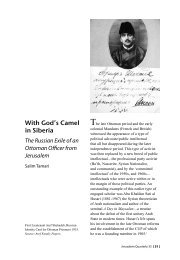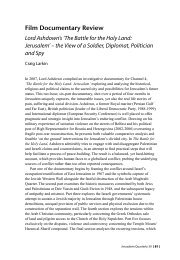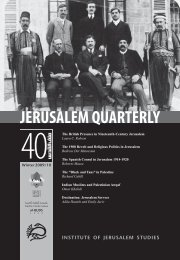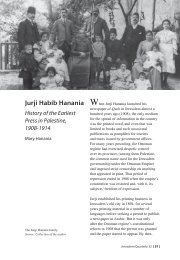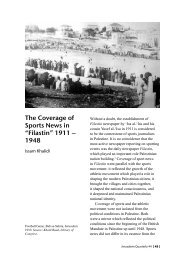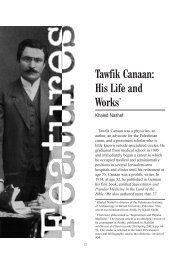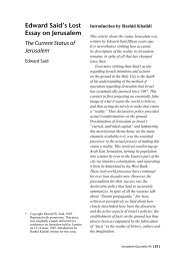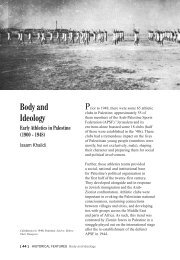PLUNDERING PALESTINE - Jerusalem Quarterly
PLUNDERING PALESTINE - Jerusalem Quarterly
PLUNDERING PALESTINE - Jerusalem Quarterly
Create successful ePaper yourself
Turn your PDF publications into a flip-book with our unique Google optimized e-Paper software.
1995, the PA was given jurisdiction over areas of the West Bank. Under the Oslo II<br />
Agreement there is to be a phased transfer of responsibility for archaeology from<br />
Israel’s Civil Administration to PA. Although not strictly part of internal domestic<br />
law, these agreements have serious implications for the protection of cultural<br />
heritage and the administration of archaeological sites. Under the terms of the<br />
handover, control of archaeology is limited to areas under the territorial jurisdiction<br />
of Palestine (areas A and B, approximately 40 percent of the land), meaning that<br />
Israel still maintains control of the administration of cultural heritage in some areas<br />
of Palestine. Under Article 2(3) of the Oslo II Agreement, the PA is obligated to<br />
prevent damage and to safeguard sites. The Palestinian Authority must also ensure<br />
free access to archaeological sites, which are regarded as holy or which hold special<br />
archaeological value (Article 2(7)). No such reciprocal provision is expected of the<br />
Civil Administration and in some cases Palestinians are denied access to those sites<br />
in Palestine under Israeli jurisdiction. 37 However, both sides are to undertake steps to<br />
prevent theft from archaeological sites and to enforce prohibitions on illegal trading<br />
to prevent the movement of material from the West Bank and the Gaza Strip to Israel<br />
and abroad (Oslo II Agreement Section 5.2). Furthering this goal, in 1996, Palestine<br />
banned the legal trade in antiquities in the areas under their jurisdiction, effectively<br />
putting dealers in Bethlehem, Hebron, Jericho, and the Gaza Strip out of business.<br />
Established in the early days of the Oslo II Agreement, the Palestinian DOA inherited<br />
the various legislative efforts (AO 1929, Temporary Law No. 51 on Antiquities of<br />
Jordan, and Israeli military orders No. 462 and No. 1166) aimed at cultural heritage<br />
protection. In an effort to combat any deficiencies, 38 loopholes and contradictions in<br />
these laws, the Palestinian DOA has drafted legislation (5 th Draft Cultural and Natural<br />
Heritage Law 2003) that “takes into consideration the scientific, legal and conceptual<br />
development of archaeology to the present time.” 39 Although strengthening some<br />
aspects of cultural heritage protection, the draft legislation is somewhat vague on<br />
issues of national patrimony and the legal trade in antiquities.<br />
For example, Article 3, under Objectives of the Draft Law, states: “This law aims at<br />
enhancing and ensuring the protection of Cultural and Natural Heritage in Palestine<br />
which belongs to the Palestinian people, in full respect of private ownership”<br />
[emphasis mine]. This article is vastly different from the AL 1978, which states: “2. (a)<br />
Where an antiquity is discovered or found in Israel after the coming into force of this<br />
Law, it shall within boundaries fixed by the Director become the property of the State”<br />
[emphasis mine] (AL 1978 Chapter 2 Section 2(a)). This leads to the question of<br />
whether the new cultural heritage law in Palestine is a national patrimony law. 40 Later<br />
Articles (7 and 8) covering private ownership, exportation, and the trade in antiquities<br />
indicate that the private sale and ownership of cultural heritage is permitted but with<br />
the permission of the Palestinian government, although there appear to be some<br />
contradictions within the text.<br />
<strong>Jerusalem</strong> <strong>Quarterly</strong> 33 [ 31 ]


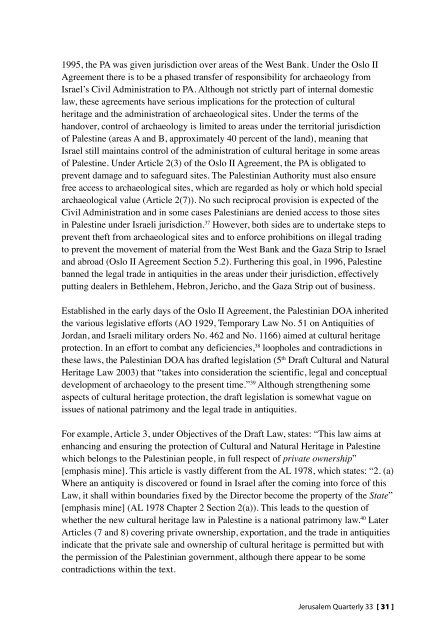
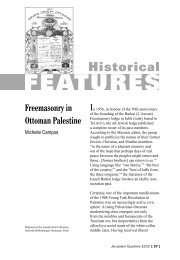
![In Search of Jerusalem Airport [pdf] - Jerusalem Quarterly](https://img.yumpu.com/49007736/1/180x260/in-search-of-jerusalem-airport-pdf-jerusalem-quarterly.jpg?quality=85)

